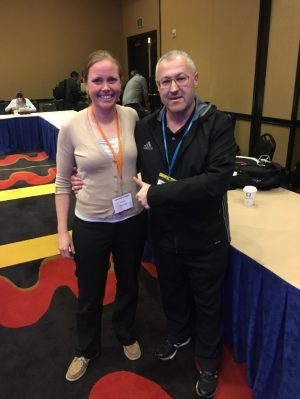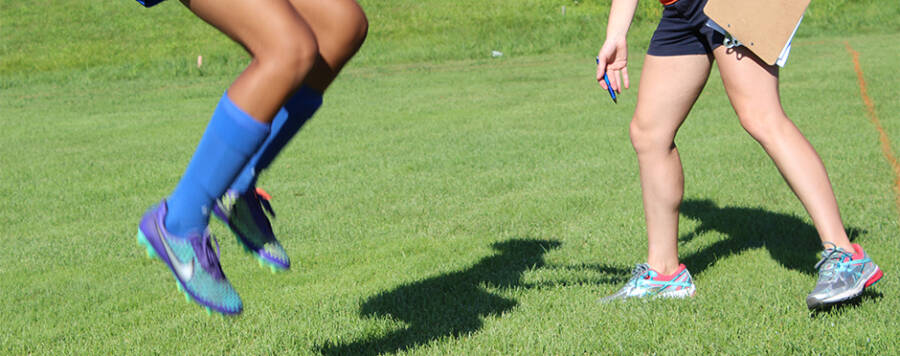To reduce the number of ACL injuries and improve the outcomes for athletes that suffer an injury, Athletico Physical Therapy offers the ACL 3P Program, which stands for Prevention, Progression and Performance. As program manager of this program, I frequently get asked by physicians, athletes and parents if ACL tears can be prevented. Although contact injuries cannot be prevented, there is evidence to support prevention programs can decrease the risk of non-contact ACL injuries – particularly in female adolescent athletes.
Athletico’s ACL 3P Program
Athletico’s ACL 3P Program helps minimize the risk of ACL injury and restores strength and normal mechanics post-ACL surgery. Prevention in the 3P program begins with a screening to identify potential injury risk factors that can be corrected. Unlike other movement screens that just look at double-leg tasks like squatting and lunging, Athletico’s ACL 3P screen looks at both double-leg and single-leg activities that include jumping and cutting (quickly switching direction), which are the two most common mechanisms of non-contact ACL injury.
By screening athletes, we are not necessarily predicting injury. Rather, we are gathering baseline measurements and identifying impairments that can lead to biomechanical flaws and the increased potential for injury. Athletico offers sport-specific ACL risk assessments for individual athletes or for entire sports teams in the community. In addition, Athletico ACL 3P clinicians are available to teach dynamic warm-up programs. It is important to note that studies show dynamic warm-up programs can decrease non-contact ACL injury risk by up to 70 percent.2
Dynamic Warm-Up Programs

U.S. Soccer started a campaign to decrease knee injuries in athletes and promoted two popular dynamic warm-up programs – the PEP (Prevent injury and Enhance Performance) and the I am often asked my opinion on which program is better, and my answer is whichever one you will use consistently! Compliance with these programs is critical.
FIFA 11+ is a great dynamic warm-up program that is structured into three different parts. Part One includes dynamic stretches and partner contacts, such as shoulder bumps, to work on landing mechanics. Part Two includes six strengthening exercises with three levels of progressing difficulty. Part Three includes planting and cutting exercises at high speed. When performed at least twice per week, studies show that injuries have been reduced 30-50 percent.2
PEP is another great ACL prevention program that includes warm-up, strengthening exercises, plyometrics, agility exercises and stretching. This program also provides specific recommendations for younger athletes.
Other Recommendations
In addition to formal dynamic warm-up programs, I recommend athletes keep their hips and core strong. When in season, typically a one day per week home exercise program is sufficient. During the off-season, exercises should be done at least three days per week.
In addition, coaches always ask me to assist their players in becoming faster and more explosive. I explain that athletes cannot further develop these skills until they learn how to decelerate and load properly. Eccentric hamstring/quad exercises in addition to hip and core strength are critical for decelerating properly. Athletico’s ACL 3P clinicians can provide a comprehensive and individualized program to address both of these skills, improve athletes’ performance and reduce the risk of ACL injuries.
If you are interested in an ACL risk assessment or having a dynamic warm-up program taught to your team, please email ACL@athletico.com.
The Athletico blog is an educational resource written by Athletico employees. Athletico bloggers are licensed professionals who abide by the code of ethics outlined by their respective professional associations. The content published in blog posts represents the opinion of the individual author based on their expertise and experience. The content provided in this blog is for informational purposes only, does not constitute medical advice and should not be relied on for making personal health decisions.
1. “Anterior Cruciate Ligament (ACL) Injuries.”OrthoInfo. American Academy of Orthopaedic Surgeons, 01 Mar. 2014. Web. 02 May 2017. <https://orthoinfo.aaos.org/topic.cfm?topic=a00549>.
2. Gilchrist et al. A randomized controlled trial to prevent non-contact anterior cruciate ligament injuries in female collegiate soccer players. AJSM. 2008; 36(8): 1476-1483.

 width="900"
height="356"
>
width="900"
height="356"
>
